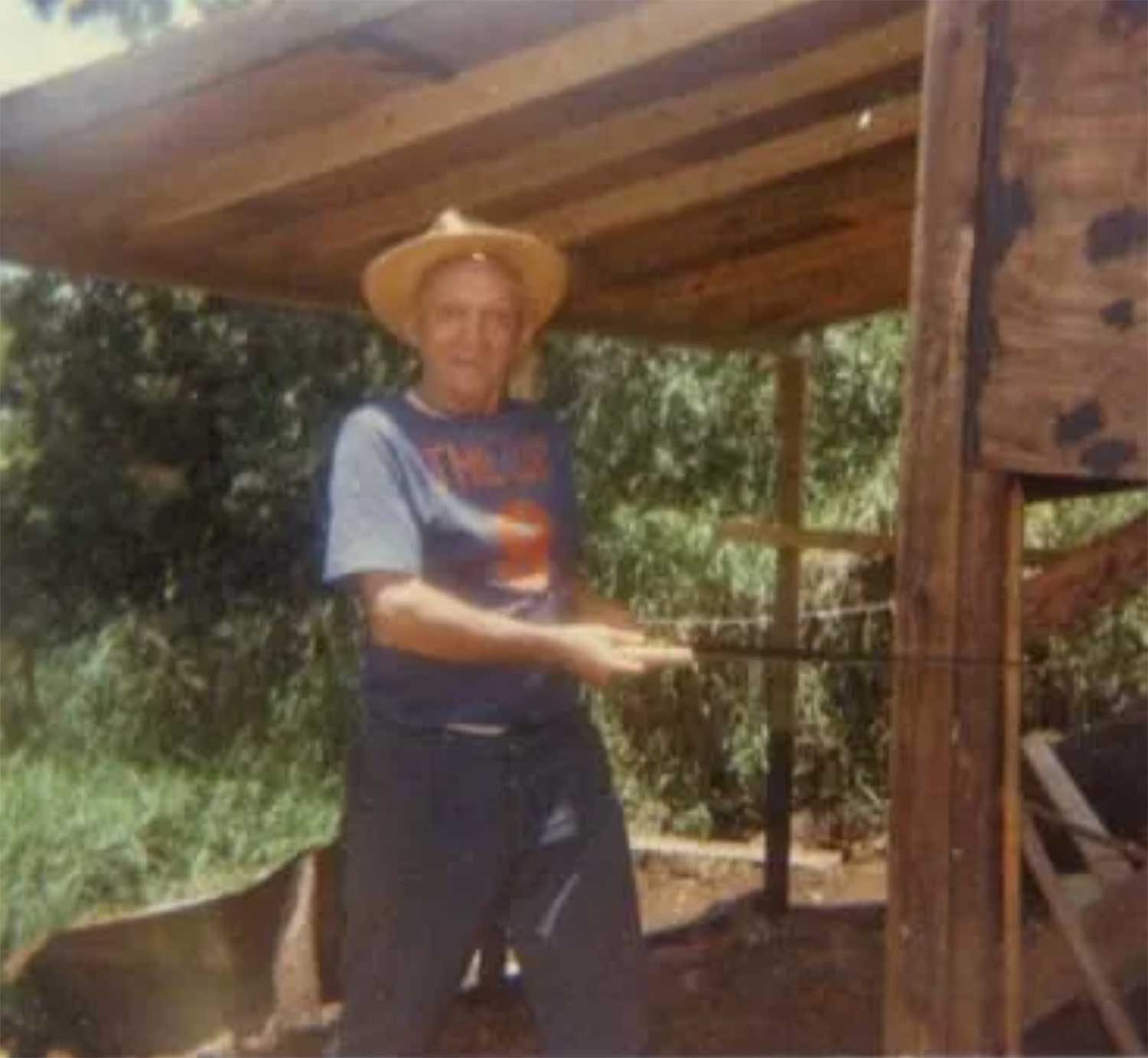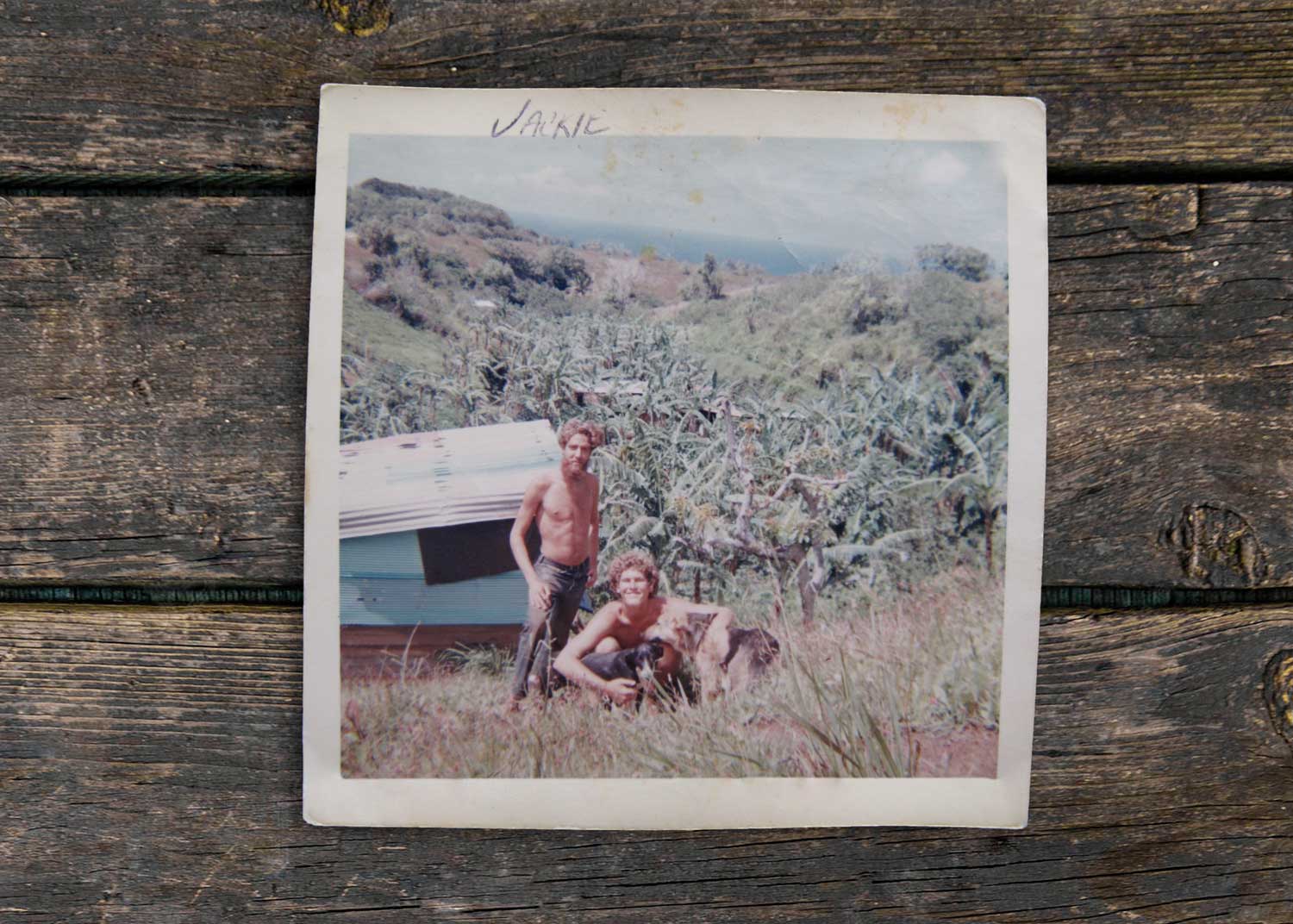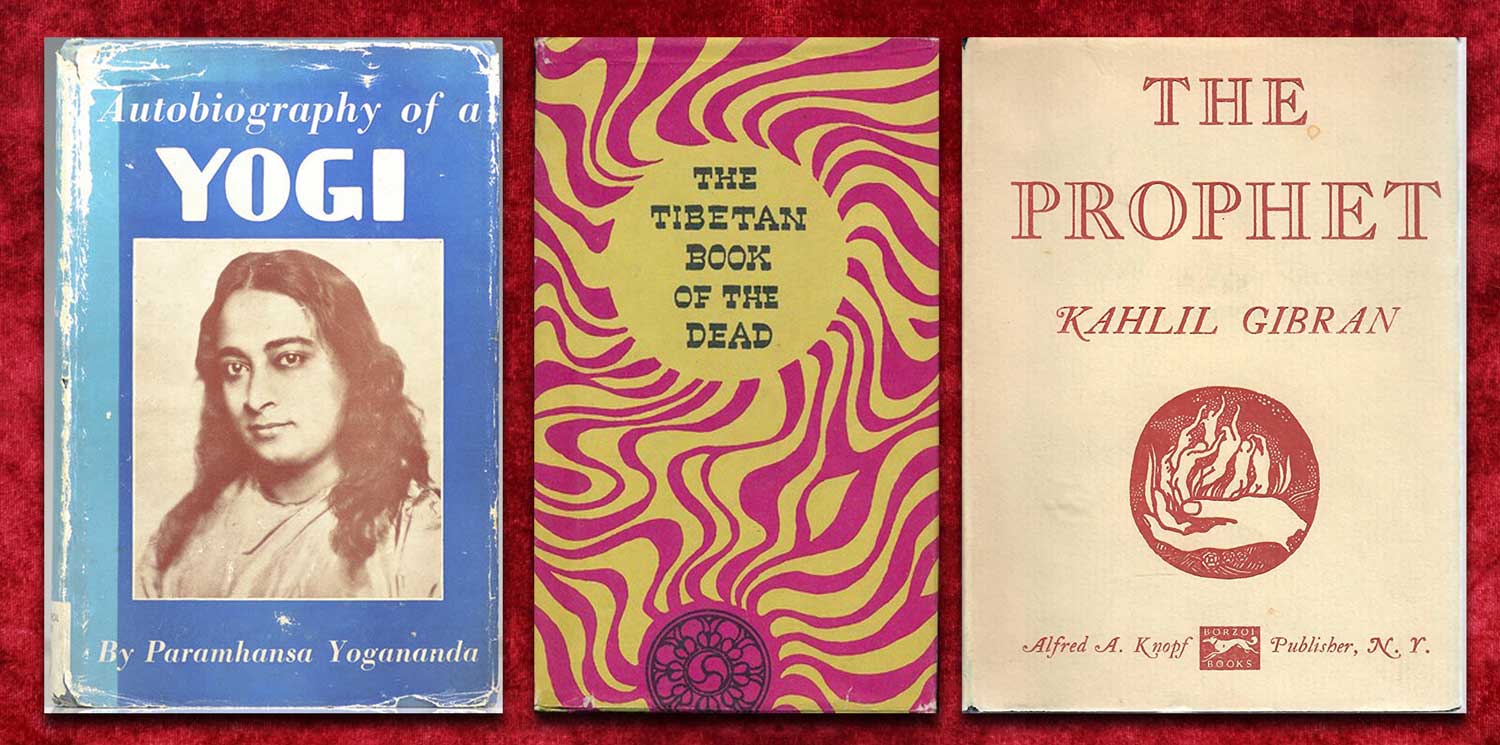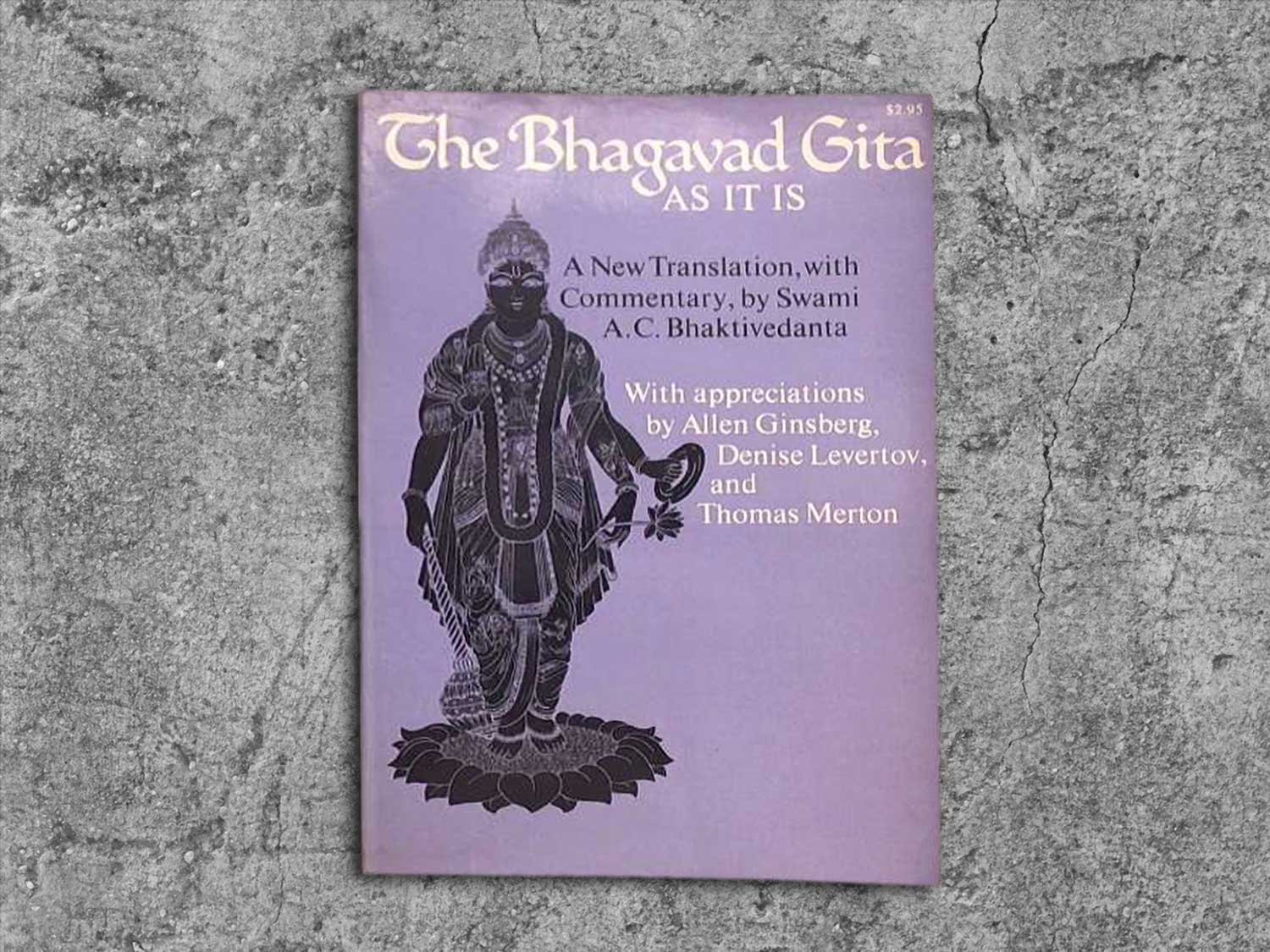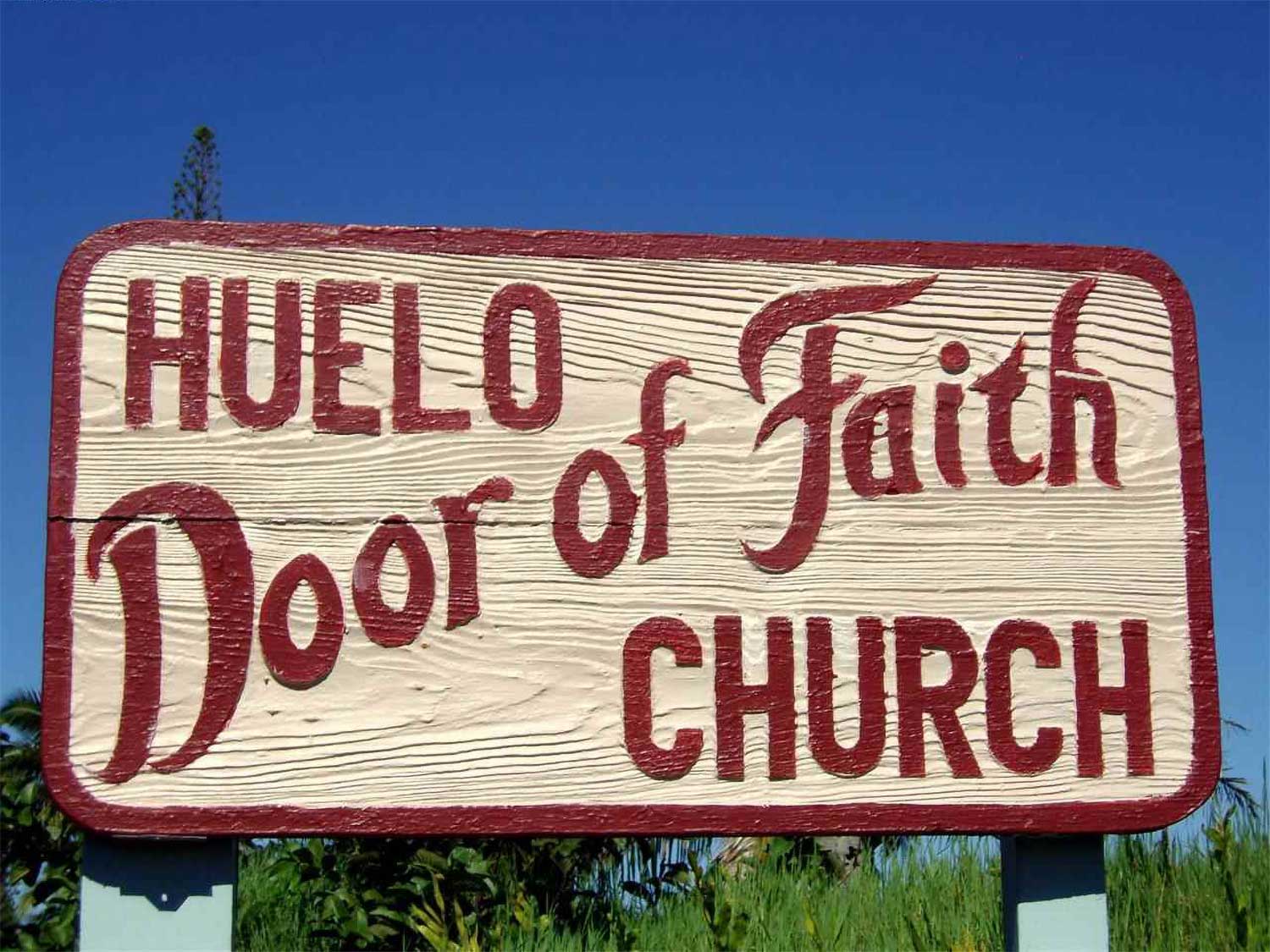Ācārya Siṁha
The Life of Swami Bhakti Gaurava Narasiṅgha Mahārāja
Chapter 5 – The Banana Patch
(1969)
The Banana Patch (or simply ‘The Patch’ as it was widely known) was a commune on Maui, Hawaii which had been in existence since 1964. It was started by an older man named David Joseph, who had bought a huge plantation off his father-in-law in 1950. He was a ‘happa-howlie’ – a local term for someone whose forefathers were mainlanders, but had mixed with Hawaiian blood. Joseph allowed newcomers to build their dwellings on his land as long as they were vegetarian and didn’t fight amongst themselves. It was a natural haven for hippies, bohemians, spiritualists and the like to gravitate towards.
David Joseph at the Banana Patch in Huelo, Hawaii
Swami Narasiṅgha: David was like an angel. He was very sympathetic to young people and he was a shelter to them. He was also a man of discrimination. It wasn’t a free-for-all inside his commune. He divided it into three parts. The ordinary hippies who were smoking gāñjā and those things lived in the Lower Valley. That was for the over-nighters. The middle valley was for families and people who wanted to settle down and build their ideal jungle house – that place was neat and tidy. It was for the kind of people that didn’t just end up in jail. They were a higher quality of hippy. A couple of my friends did that. Those that were into just meditation and associated spiritual practices, he designated to the Upper Valley. That was were David’s ranch house was, but he didn’t live there. There was a gigantic fat Hawaiian living there. He was a character – he was so big I don’t think I ever saw him on his feet! When he was sitting, he looked like he was standing. I remember there was also one older lady who was very tall, about ten years older than me at the time. She was a hermit. She stayed in the upper valley. She didn’t talk to anyone, but just meditated and did her own thing.
So I went to The Patch and told David I wanted to practice yoga, so he took me to a place among the banana trees and coconut trees and he said, “Okay, this is your spot. I’ll take you to this place nearby where there’s some World War II Filipino labour housing. You can deconstruct it, bring it back here, and you can construct whatever you like.” So that was great. I made myself a 12 X 12 tin and wood hut on stilts with a trap door entry. You entered through the trap door, and when you shut it, there was no way to get up there. There was nothing to hide, but I just decided to do like that. I lived there for over a year, intensifying my practice of yoga.
Swami Narasingha Maharaja (left) at the Banana Patch in 1969
Alone in his hut, Mahārāja would wake up early in the morning and practice yoga for most of the day. Before flying to Maui he had bought a copy of The Complete Illustrated Book of Yoga by Swami Vishnudevananda. Armed with this, as well as what he had learned from Kris Wright and his friend in prison, he eventually mastered various āsanas as well as uddiyāna-bandha, naulī-kriyā etc. On top of this he would wake up at midnight and engage in various forms of prāṇāyāma.
Mahārāja became more and more serious about his daily yoga practice. One day, he suddenly decided that in order to aid his concentration, he would go on a fast for ten days straight only drinking coconut water. On the tenth day he terminated his fast by eating a large avocado sandwich, but his stomach had shrunk so much that for the whole night he suffered from severe abdominal cramps.
Near to The Patch were many abandoned plots that had been originally created by Filipino gardeners during World War II. The trees there had reseeded and fruit was in abundance. Considering how much free fruit was available, Mahārāja became a fruitarian. For six months all he ate was coconuts, yogurt, bananas, pineapples, avocados, milk and honey.
Narasiṅgha Mahārāja: I had all these different books on religion and I wanted to knuckle down and read them to understand what is God. I read “Autobiography of a Yogi,’ ‘The Tibetan Book of the Dead’ and ‘The Prophet’ and other books of Kahlil Gibran. These were the ‘spiritual books’ of the time. Amongst all these books, somebody had given me a copy of Śrīla Prabhupāda’s Bhagavad-gītā. So when I started to read it, the first thing Prabhupāda says in the purport to the first verse is –
“Bhagavad-gītā is the widely read theistic science summarized in the Gītā-māhātmya (Glorification of the Gītā). There it says that one should read Bhagavad-gītā very scrutinizingly with the help of a person who is a devotee of Śrī Kṛṣṇa and try to understand it…”
I was just living alone, so I thought, “Well, I guess I can’t go on with this one. It requires the help of a person who is a devotee of Kṛṣṇa, and they’re not around.” So I just closed the book.
In his quest for enlightenment, Mahārāja began exploring various religious paths. He went to a zendo in Maui where he studied Za Zen, he checked out Tai Chi, and he even took up a Hawaiian version of Christianity at the Door of Faith Church in Huelo. His thinking was that Jesus and Buddha must have been yogīs of some sort.
The name of the preacher in charge of the Door of Faith Church was Mama Papa Una. She was a big lady with a big heart and was a motherly figure, which was the main attraction to all the young people who attended the church.
Narasiṅgha Mahārāja: One week after church, Mama Papa Una announced that we would have a picnic in the park that evening. Me and my friends decided we would go, but we were all vegetarians. When we went to the picnic they were cooking about 300 chickens – what is called in Hawaii ‘Hui Hui Chicken.’ I had a confrontation with Mama Papa Una and I said, “Mama, if Jesus came here, he would not eat chicken. He’d eat watermelon, mango, fruits, vegetables and all these many things.” She said, “No, no, it doesn’t matter. It’s okay.” I told her, “Ask the chicken if it’s okay! The chicken also wants to live, so it’s not okay!” That became the cut. I thought, “Jesus is good, Christianity is bad!”
A few months after Mahārāja had been at The Banana Patch, a new resident suddenly arrived. Kris Wright had moved in across from Mahārāja in the upper valley and was staying in a tree house near David’s ranch house. They had lost touch since their first meeting in Mexico. Mahārāja told Kris about his escapades in prison and Kris also had an interesting story to tell Mahārāja.
Narasiṅgha Mahārāja: In September 1968, Kris had visited an ‘Indian swami’ in Santa Fe. But later, he got it into his head to go to the Yucatan to live with some Mayan Indians and eat sacred mushrooms. At the time he was staying in a town called Mazatlan. From Mazatlan, Kris headed for the Yucatan via Mexico City. I believe it was sometime in November of 1968. Stopping at the Mexico City post office on the way, Kris wrote a letter to the swami who turned out to be Śrīla Prabhupāda. He addressed his letter to the Los Angeles Krishna temple on La Cienega Boulevard. He got the address off a ‘Love Feast’ invitation he had received a while back. Kris respectfully informed Prabhupāda in that letter that he was traveling the world in search of God. What Kris didn’t mention, however, was that he was regularly taking LSD in his search. Kris gave a return address as “Kris Wright c/o General Delivery, Mexico City, Mexico” and continued on to the Yucatan. In the Yucatan, Kris stayed in a village (that he later described as a village of drunkards), but didn’t find any sacred mushrooms or spiritual Mayans there. After a few weeks and fully disillusioned, Kris headed back to California via Mexico City. Stopping by the post office, Kris asked the guy behind the counter if he had any mail for Kris Wright? Disappearing for a few minutes into the backroom, the postman reemerged with an aerogram in his hand. It was from Śrīla Prabhupāda. Prabhupāda had written:
My Dear Kris,
Please accept my blessings. I thank you very much for your nice letter and have noted the contents carefully. Yes, you were very kind to massage when I was there in Santa Fe, and I thank you very much for this.
I have noted your questions carefully, and regarding your question about the Prasadam recipes; Krishna is offered foodstuff in goodness. The foodstuffs in the modes of goodness are wheat, rice, pulse (beans, peas), sugar, honey, butter and all milk preparations, vegetables, flowers, fruits, grains. So these foods can be offered in any shape, but prepared in various ways by the intelligence of the devotees. The ingredients are always the same as above, whether you fry them, boil them, bake them, powder them, or whatever way they are combined or cooked, the idea is that they must come from this group of foodstuffs. So you can make your own recipe if you like, so long as the ingredients are within this group. This foods group is stated by Krishna in the Bhagavad-gita, and we follow accordingly. Now the thing is that you must consider by whom you are being taught what is healthy and what is not healthy. What is their authority? Actually, this healthy and non-healthy is a material consideration, and we are simply interested in what Krishna wants, so we offer to Him to eat whatever He wants. And He asks for food preparations from within this group. I hope this will clarify the questions about Prasadam preparations for you to understand.
Regarding your question about Yogananda, you write to say that you “received the impression from his autobiography that he was a genuine saint who dedicated his life to serving God.” But the thing is that you do not actually know what is a genuine saint, and what can you understand about saintly life from reading his autobiography. I may inform you that just recently I visited his so-called ashram retreat, and it was simply a hodge-podge of all nonsense. There was a Buddha statue, a Christ statue, a Gandhi’s memorium labeled as “World Peace Memorium”—and what world peace he has brought? None. And what does Gandhi have to do with spiritual realization anyway? Gandhi was simply interested to get the Britishers out of India—what has this to do with self-realization, the prime goal of life? And here and there, there were signs of all sorts, like “Be still and realize I am God”—what is this, by becoming silent and still one becomes God?! The stone is silent for millions of years, does that mean it has become God? This is all conglomeration of nonsense ideas. Practically, this Yogananda has no philosophy or authority, he simply drags in Buddha, Jesus Christ, Gandhi, and whoever else he can think to put, so that whatever you like it is in his shop. He is just a good shopkeeper.
Krishna says – Give up all nonsense engagements and come here and surrender unto Me! – that is real philosophy. Krishna says that anyone who is worshiping any demigod, it is all nonsense, and just give it up and come to me. Our philosophy is to worship Radha and Krishna. We don’t make any hodge-podge or any compromise. If you like you can accept it, and if you are fortunate you will accept, and be happy, but this hodge-podge nonsense will never help you. Just like we prescribe certain rules and restrictions for our disciples so that they can make real advancement in spiritual life. This Yogananda gives no restrictions or regulative principles to his disciples, and thereby collects all nonsense class of men. But if you put restrictions then not so many men will come, but sincere ones will come, those who are actually sincerely searching after real spiritual life. This Yogananda accepts everything as bona fide, because he simply doesn’t know what is bona fide and what is nonsense. So there is no need to waste your time.
I can understand you are planning to go on world tour, but I think there is no need for wasting your time on such world tour. Better you chant Hare Krishna sitting in one place, that is far better. What for you want to go on world tour—people everywhere are doing the same thing, eating, sleeping, mating, and defending – each in some slightly different way, but same substance is there. There are the same streets, same people, same cars, same trees, etc. everywhere, somewhere a hill, somewhere sandy, somewhere some water—but what is the profit of seeing so much scenery? It is better if you want to travel, you can travel to preach and spread this Krishna Consciousness to the suffering humanity at large. You can travel with our sankirtana party if you like. They are presently here in Los Angeles, and they are making program to go to London, then over Europe, then eventually on to India, etc. So if you want to travel I recommend you travel with them, and chant Hare Krishna with them wherever you go. And you will profit by this sort of travel, whereas the other is a waste of time practically. So that is my opinion, that you would do far better not to waste your time in this way.
Thanking you once more for your letter, and hoping this meets you in good health and I remain
Your ever well-wisher,
A.C. Bhaktivedanta Swami
When Kris read the letter to him, Mahārāja thought it was the most spiritual thing he had ever heard. Upon receiving Prabhupāda’s letter, Kris had returned to the US, joined the temple in San Francisco as a brahmacārī and taken initiation from Śrīla Prabhupāda. After a couple of months however, he left and fell back into his old habits. He went back to see his friends in San Diego and finally decided to move to the Banana Patch. Kris recounted stories to Mahārāja such as how he was there when the first mṛdaṅga arrived from India and how Prabhupāda tore some of his saffron cloth to cover the drum. Kris also taught Mahārāja how to chant japa.
Narasiṅgha Mahārāja: Kris explained to me how to offer food to Kṛṣṇa and told me about fasting on Ekādaśī – every once in a while, he would tell me it was Ekādaśi and I’d say, “Cool!” and we would follow Ekādaśī (whatever that was!). Actually I was already following Ekādaśī every day because I was a fruitarian during that time. If we ever did cook anything, myself and Kris would cook in David’s kitchen.
Since Hawaii was a welfare state, Mahārāja and Kris would get food stamps from the government. They would hike out to little towns on the island, and with their stamps they would purchase basic amenities such as toothpaste etc, and spend the rest of their stamps on honey.
One morning, while Mahārāja was in his shack meditating, he heard the shrill screams of the gigantic Hawaiian at David’s ranch house. Mahārāja ignored the yelling until he suddenly heard a loud crackling sound. Opening the trap door and jumping down, he looked towards David’s residence. The big Hawaiian was standing on the verandah wailing and flailing his flabby arms frantically, while Kris’s bamboo and timber tree house was engulfed in flames. Mahārāja saw Kris walking towards him with a bag over his shoulder. He was leaving and for reasons only known to him, had decided to burn down his hut before going. He came up to Mahārāja, they said their goodbyes and they never saw each other again.
Mahārāja and the other residents of the Banana Patch continued with their idyllic lives, but meanwhile David Joseph became embroiled in a legal battle. Local authorities in Maui claimed that Joseph was guilty of 28 violations concerning building codes, land use laws and health regulations. The old man faced $15,000 in fines and two years in jail. Local police conducted frequent raids on The Patch to intimidate David Joseph and the residents, and many court cases ensued. In the meantime, Mahārāja had been visiting an āśrama in Haiku known as the Haiku Meditation Center whose members chanted Hare Kṛṣṇa.
Narasiṅgha Mahārāja: I used to frequent there at least once or twice a month. They would have these seminars, and they were a good canvassing group. You didn’t necessarily enter at the bottom. You entered according to whatever spiritual state you were already in. Not many newbies to spirituality ended up at at the Haiku Meditation Center. It had some principles, it had some leadership – of course, it was all whacky, but it had something.
People from the Center used to come to the Banana Patch every once in a while and have bhajanas and kīrtanas. They would wonder through the commune in a trail of people and they would chant. I got to know them and every time I heard them coming I would chop up a bunch of bananas and pineapple, have them over to my hut and we would have a feast.
Mahārāja’s yoga practice, chanting japa and meditation had given him a view of where he wanted to go in life and what he wanted to do. Yet he didn’t really have a guru, He knew that such things existed, but where could you find a guru in Maui in 1969? There was the teacher at the Zen Do and the visiting Tai Chi master, but they were not what he was looking for. For Mahārāja, yoga meant guru – not a Zen teacher, a Tai Chi master, a pastor, or a preacher.
Narasiṅgha Mahārāja: I didn’t really have a yoga-guru. I had a book and had picked up whatever I could along the way from others. But if you don’t have a proper yoga-guru then you could get in trouble! You could choke to death, strangle yourself, get a serious cramp and get locked in a contorted position which could cause you some serious damage. In fact, that is what happened to me at the Banana Patch while doing pūrṇa-matsyendrāsana (a full spinal twist). I had done it before, but somehow one morning while doing that, I lost my balance and the joint in my knee popped right out of its socket. I lay flat for a while and could hardly walk for days. My knee never recovered from that.
In the two or three months that my knee was healing I had more time to spend on the other things, because my āsanas were over for a while. While I was doing some prāṇāyāma, I found a nice little cave in a cliff overlooking the ocean. I planned it all out – I took enough fruit and coconut water to last what I thought would be about a week, and I repelled down this cliff and into this cave to meditate. I lasted three days. I was trying to meditate on Oṁ, but I soon found out that I wasn’t ready for that stage to go and meditate in absolute solitude.
The peaceful life of yoga and meditation that he initially found at the Banana Patch was slowly being eroded by the legal struggles between the Joseph family and the local authorities. Furthermore, due to his knee injury, Mahārāja could not continue with his daily yoga practice. He had already made several close friends among the leading members of the Haiku Meditation Center, so after thanking David Joseph for his hospitality, he decided to leave The Patch and move there.

